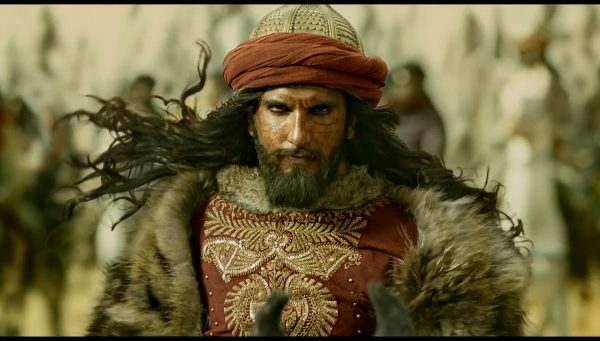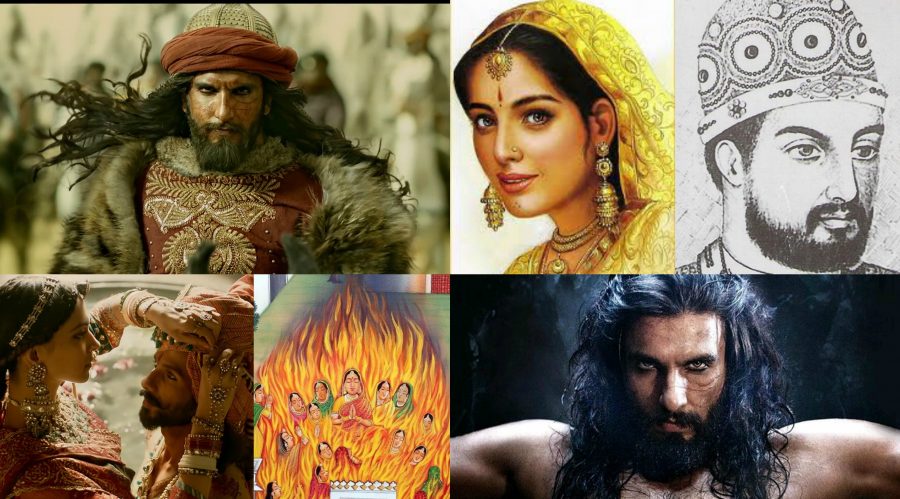The story of Rani Padmini has inspired many adaptions – on-screen and off-screen. In 1540 CE, Malik Muhammad Jayasi wrote a fictionalised version of the historical events in Awadhi epic poem Padmavat. From then on, several other accounts flourished, in some cases the actual turn of events might have gotten lost in translation.
In history textbooks, we learn of Rani Padmini and her purity. Of how she protected her honour by committing Jauhar, the practice of self-immolation, before the barbaric Alauddin Khilji and his men plundered Chittor. In school, they never really specified what this ‘honour’ stood for, no one had to give it much thought. No one would’ve imagined about the possible sexual connotations to honour, something which the Karni Senas, who have heavily opposed Sanjay Leela Bhansali’s film, like to point out.
But there are far too many versions for one to assume which one is authentic and which one isn’t.
Going by the trailer of Sanjay Leela Bhansali’s magnum opus, one knows that he has tried hard to be as safe as possible, catering to the Hindu right-wing’s idea of the epic poem where Rani Padmini is the pious, righteous woman, Maharawal Ratan Singh is the valiant husband and Rajput king, and Alauddin Khilji is portrayed as the barbaric warrior, especially since he grits his teeth, leaves his hair and beard unkempt, and sports animal-like mannerisms.

The whole existence of these alleged historic figures are debatable, especially since Jayasi’s version was a fictional retelling of something that has never been proven if it was true or hearsay. It begins with a talking parrot, Ratan Singh enamoured by what he hears of her, they fall in love and get married, a Brahmin is banished and he heads to Khilji and describes the beauty of Rani Padmini. Khilji falls for Padmini even before meeting her, and thus the war begins. While the story represents defending honour and the bravery of the Rajputs, in this age and time, it’s patriarchal showcasing how women had absolutely no agency over their bodies, reducing them to dolled-up objects as opposed to human beings who were known for more than their mythical beauty.
***
On Alauddin Khilji:
While early historians had taken the epic poem into account as authentic. Later, modern historians now have dubbed it as “unhistorical” and “inaccurate”.
Scroll.in did an in-depth look at how Jayasi’s work is mostly attributed to a source he heavily relied on. Aziz Ahmad, in his paper Epic and Counter-Epic in Medieval India, pointed out that Jayasi drew much of his inspiration from Nayachandra Suri’s Hammira Mahakavya. The epic by Suri in the 15th Century is largely a legendary biography of the 14th Century Chauhana king Hammira Mahadeva. The story involves Khilji, the Delhi sultan, and how he offers a truce to the Chauhana king by asking his daughter’s hand in marriage. While she agrees, Hammira refuses, calling him an “unclean mlechcha” (barbarian). And much like in Padmavat, the Chauhana women resort to self-immolation to protect their honour.
But while Khilji is always held up for his “barbaric” nature, several historians have pointed out how his market reforms continue to be a cause of wonder to contemporaries. Satish Chandra in his book Medieval India: From Sultanat to the Mughals – Delhi Sultanat (1206-1526), wrote how Khalji’s (or Khilji) market reforms were oriented more towards administrative and military necessities as opposed to internal restructuring. Khalji was more or less the first ruler who looked at the problem of price control in a systematic manner, while the other rulers often failed to control the prices.
Bhansali’s portrayal of Khilji has been slammed and appreciated. Speaking to Media India Group, Vijayant Singh, a professor of Medieval, Early Modern Environmental Histories and Maritime narratives of South Asia, at Delhi University said that the portrayal was not appropriately done.
“The powerful ruler dressed in leather and fur, and eating like uncivilised barbarian makes the character looks completely out of place. Khalji had spent his entire life in India between Allahabad and Delhi and fighting Rajputs and Mongols. I don’t think that anyone could survive the heat of Delhi and Rajasthan in that dress. Also, Delhi was no cultural wasteland; Alauddin’s Delhi was a cultural metropolis of Islamic East in early 14th Century, with Nizamuddin Auliya, Amir Khusaru as contemporaries,” he said.
When the trailer was out, many likened Ranveer Singh’s portrayal eerily similar to that of George RR Martin’s Dothrakis from Game of Thrones. Dothrakis are considered nomadic horse-mounted warriors who are said to be born, fight, and die in the saddle. Their celebration includes drinking, raping, and dancing, while they wear animal skins, hair and beard unkempt, and have war cries loud enough to curdle your blood. Stating that Khilji’s army and Khal Drogo’s army have an uncanny resemblance would be futile.

Barbaric
***
Recommended
The Karni Senas, activists who believe they’re honouring their Rani Padmini’s honour by vandalising Bhansali’s movie sets really have nothing to worry about. If defending figures who are mostly considered fictional, with a story that serves as a quintessential portrayal of patriarchy and male dominance over a woman’s body, then there’s little to argue with the self-proclaimed activists.
Nevertheless, the costumes and effects of the battlefield and army look grand – a typical of Bhansali film where taking creative liberties is considered okay. While depicting historical periods filmmakers often take creative liberties to make the cinematic experience more engaging. While filmmakers do exhaustive research on getting the look, costumes right, some even go far and completely disregard historical facts – the flying crocodile and a bronzed up Hrithik Roshan in Ashutosh Gowariker’s Mohenjo Daro looked completely out of place and even comical.
Jointly produced by Bhansali Productions and Viacom 18 Motion Pictures, Padmavati is scheduled to release on December 1.



